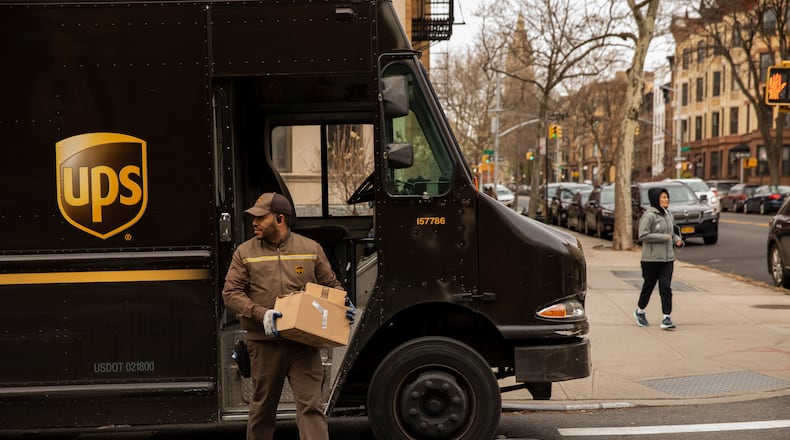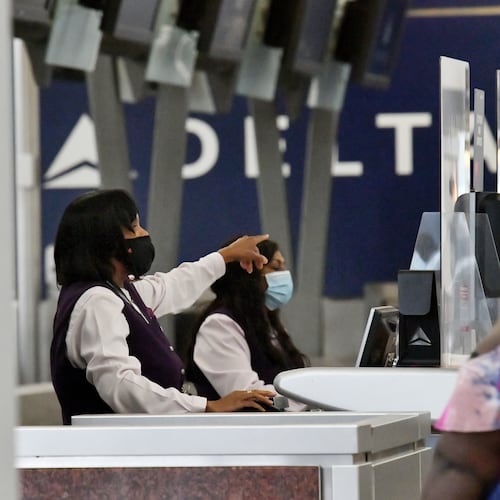Editor’s note: This article has been updated throughout with additional details, including holiday shipping volumes and delivery rates.
Parcel delivery giant UPS reported $1.4 billion in net income for 2020, a challenging year that brought a surge in online shopping capped off with a hectic holiday shipping season and the start of vaccine deliveries.
The Sandy Springs-based company booked record revenue of $84.6 billion for the year, up 14% from 2019, amid a massive shift toward e-commerce during the COVID-19 pandemic as more consumers stayed home and ordered items online.
In the busy fourth quarter, revenue soared 21% to $24.9 billion. The company delivered an average of 29.5 million packages a day, up 11% from the year before. Revenue also was boosted by peak surcharges and higher shipping rates paid by small- and medium-sized businesses.
The brisk business represents a bright spot for corporate Atlanta, where many companies large and small have suffered downturns after the coronavirus sent the economy into a tailspin. Delta Air Lines last month reported a record $12.4 billion loss in 2020 as fewer Americans took to the air and revenue plunged 64%.
But delivering individual items to doorsteps is more costly for UPS than dropping off pallets of goods at stores. Profit also was weighed down by $5.6 billion in fourth-quarter charges.
UPS CEO Carol Tomé said in a written statement she is “optimistic” about 2021, including continued deliveries of COVID-19 vaccines. The company has delivered more than 36 million vaccines in about 225,000 shipments so far.
Nonetheless, the company declined to forecast revenue or profit for 2021, citing “continued economic uncertainty due to the global pandemic.”
“There’s just still so much uncertainty,” Tomé said during an investor conference call Tuesday. “Until we get this pandemic under control, we’re just a little bit walking on Jell-O.”
In the fourth quarter, UPS took an accounting hit from $4.9 billion in non-cash, mark-to-market pension losses, a $556 million asset impairment charge for the recently announced sale of UPS Freight, and other costs. That resulted in a quarterly $3.3 billion loss.
Those items also decreased the company’s full-year net income, which UPS said would be nearly $7.2 billion excluding the pension losses driven by low interest rates and other charges. A year ago, UPS reported $4.4 billion in net income for 2019, including a $106 million fourth-quarter loss after pension and other charges.
Some of the challenges came during the record holiday shipping season when the coronavirus drove consumers to order more gifts online instead of venturing out to stores, overloading shipping networks and driving UPS and FedEx to enforce limits on how many packages they would pick up from retailers. That affected some of the companies’ biggest customers as well as smaller businesses that turned to the U.S. Postal Service — which in turn overloaded the post office and contributed to delivery delays.
Business-to-consumer shipments in the fourth quarter grew 20% year-over-year, making up two-thirds of volume at UPS. Amazon is the largest customer at UPS, and made up 13.3% of UPS revenue, up from 11.6% in the prior year.
Tomé said demand exceeded capacity by 3 million in average daily volume during the peak holiday shipping season. Controlling volume by limiting pickups helped to reduce what Tomé called “chaos costs,” including overtime pay and bottlenecks.
The on-time delivery rate at UPS for packages scheduled for delivery Dec. 20-26 was 97.6%, better than FedEx and the Postal Service, according to logistics data firm ShipMatrix.
Shipping also cost more than usual, with demand so strong that UPS implemented “material price increases” during the peak holiday season, CFRA Research analyst Colin Scarola wrote in a note to investors.
UPS always hires tens of thousands of temporary workers for the holidays, but this year cut costs by using more workers driving their own cars, with 39,000 such personal vehicle drivers.
At the same time, attempts to reduce the expense of doorstop drop-offs by encouraging consumers to pick up packages at nearby stores are “not working as well as we thought, quite candidly,” Tomé said.
UPS plans to reduce non-operating costs by more than $500 million this year, including through buyouts announced last year. Tomé said the company will be “creating fewer but more impactful jobs” and that more details will be given at an investor presentation in June.
E-commerce will continue to make up a large portion of retail sales, Tomé predicted, which is expected to continue driving up shipping revenue, including through what she called “more personalized pricing.”
UPS financial results
Revenue
2020: $84.6 billion
2019: $74.1 billion
4Q/20: $24.9 billion
4Q/19: $20.6 billion
Net income
2020: $1.4 billion profit
2019: $4.4 billion profit
4Q/20: $3.3 billion loss
4Q/19: $106 million loss
Source: UPS
About the Author
Keep Reading
The Latest
Featured




